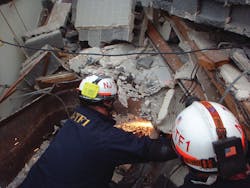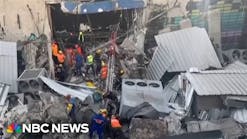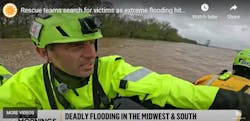We have all seen the images across the news: pictures of rescuers and support personnel carrying victims, both lifeless and animated, from the rubble piles of natural disasters, acts of terrorism, earthquakes and tornadoes. This is not for everybody; there are reasons they are called “Special Operations.” These responses push rescuers through exhaustion, frustration and jubilation throughout the deployment. The people who fill these positions are driven and committed to stand vigilant in times of tragedy and heartbreak.
What continually gets missed in these stories, however, is the preparation, coordination and maintenance necessary to keep urban search and rescue (USAR) task forces ready to respond at a moment’s notice.
Many tasks must be accomplished on-scene to lead up to the images we see on the news. Planning Specialists gather and coordinate vital information in the development of the Task Force Tactical Action Plan. Hazardous Materials Specialists make their way into the scene, confirming the safety of the atmosphere the victims are potentially located. Search Specialists comb the pile with cameras and canine companions that can find even the significantly entombed victims. Structures Specialists evaluate the debris and recommend types of shoring and their specific locations in order to keep the victims and the responders safe while they are operating. Medical Specialists provide critical care and life-saving procedures to the injured while operations continue in the arena. Rescue Specialists perform the sometimes intricate task of disentanglement and extraction of victims from the remains of the debris (see photo 1). But there is a significant position on this team that makes all of the above-mentioned operations possible: logistics.
Logistics Assignments
One of the many considerations that Logistics Specialists are responsible for is to make sure the USAR tool and equipment cache is kept in a state of constant readiness (see photo 2). This responsibility is defined in the USAR “Task Force Position Description” as:
- Coordinating the packaging and transporting, distribution and maintenance of the task force equipment cache prior, during and subsequent to mission assignments
- Coordinating with officials for transportation needs, including personnel
- Procuring equipment as directed by the Logistics Manager
- Ensuring accountability and security of the task force cache
- Maintain timely records and reports
- Adhering to all safety procedures
- Maintaining and repairing the task force equipment cache
- Assisting with the management of task force facilities and fleets
Logistics Managers must be proficient in all of the previously mentioned responsibilities, and are also responsible for:
- Completing all task force transportation documents
- Coordinating and managing all Logistics activities
- Conducting performance evaluations for all personnel
- Coordinating unit needs with the IST (Incident Support Team) Logistics Section on task force issues
- Managing the task force transportation fleet
Logistics Training & Responsibilities
All members of the USAR team are required to complete the Structural Collapse Operations training program to be able to perform at an incident (see photo 3). Each component has continued training throughout the year, and there are additional mandatory training classes for members. In the case of Logistics, there are classes that include:
- DHS/FEMA National USAR Response System GPS Awareness Level course
- DHS/FEMA National USAR Response System Logistics Specialist course
- Maintain certification as a Certifying Official for Transportation Requirements and Regulations – both air and ground
- ICS-300 in accordance with the National Standard Curriculum Training Development Guidance
There also is optional training in the field of logistics, which include Base Camp Manager, Security Manager, Ordering Manager, Forklift Operator, Ground Support Unit Leader, Food Unit Leader and Facility Unit Leader, to name just a few.
While preparing for deployments remains a paramount responsibility, consider the annual lists of updated training that all of the USAR components perform during the course of 12 months. The range or training varies from search equipment usage, radio and communications updates, atmospheric monitoring equipment testing and calibration, shoring and bracing, lifting and moving, breaking and breaching, and even oxy/acetylene torch works.
All of this training requires resources to be prepared, not only for deployments, but for refresher training. The same stresses and wear placed on the equipment during deployments is applied to the equipment during training operations. Once the classes are over, the work of cleaning, servicing and preparing the equipment begins in order for the response cache to be ready for deployment at a moment’s notice (see photo 4).
The Calling Of a “Logistician”
I have served as an evaluator for potential members when our task force held evaluations for potential new members. One constant in this process is that well over 90% of candidates try out for a spot as a “knuckle-dragger” – Jersey-speak for Rescue Specialist, a name given to us by New Jersey Task Force 1 (NJ-TF1) Task Force Leader James Riley and one we wear with pride – in the Rescue Component. Very few come to the evaluation looking for a spot in Logistics. When talking to some of our Logistics personnel, they like it that way, and for good reason – our Logistics personnel are very open to new members of their component, but one characteristics that most Logisticians agree on is that in order to be efficient in Logistics, personnel must spend time in another component before joining Logistics. Some of our Logistics personnel started out on rescue squads, and in some cases, served as squad officers. This experience allowed them to gain the experience of the needs and requirements of “working the pile,” so to speak. Being in the arena performing the work on a deployment has given them a greater understanding of how the equipment works, applications for all of the equipment, potential failures of the equipment and their components, and additional support equipment and tools that would be needed in the field should the tool become damaged (see photo 5).
Also, the potential for continuing education on the tools and equipment in the cache from manufacturers assists in making them the “subject-matter expert” when it comes to operating and maintaining the equipment. Improvements and upgrades to the tool cache can be better judged prior to purchase and acquisition by Logistics members with the proven training and experience from that specific component.
Conclusion
In his book Engineering Practical Rope Rescue Systems, Mike Brown discusses the “Team Efficiency Concept” and stresses the overall importance of getting the team members to “buy in” to the concept. In the emergency services, there are very few, if any, tasks that can be accomplished by a single person; in USAR, every operation is accomplished by members who embrace the “team concept.”
So the next time the news media show a video or pictures of a victim being released from the clutches of devastation, consider the steps that made those images possible. Preparation, planning, monitoring, searching, communicating, treating, lifting, shoring, breaking and breaching – many hands were involved in moving that victim to safety beyond those carrying the litter.
• • •
Author’s note: I would be remiss if I did not thank those who provided great insight for this article and continue to stand at the ready for when the time comes that we are called into action. A great amount of thanks, respect and true admiration go to the greatest “Logisticians/Magicians” I know: Joe Ward, Lenny Dotson, Jason Palmer, Walt Milne and the supporting staff with NJ-TF1. Their continued commitment and dedication to the mission serves as inspiration to those who honorably stand alongside each of them.
MIKE DALEY has spent nearly 25 years in the fire service and has held many officer positions in career and volunteer fire departments. He is currently a lieutenant and training officer with Monroe Township Fire District 3 and an instructor at the Middlesex County Fire Academy, where he is responsible for Fire and Rescue Training Curriculum development. Daley also is a rescue officer with the New Jersey Task Force 1 – Urban Search and Rescue team. He holds certifications as Rescue Technician, Incident Safety Officer, Hazardous Materials Specialist and On-Scene Incident Commander, EMT, Level II Fire Instructor, SCBA/Smokehouse and Live Burn Instructor, Fire Inspector, and Fire Officer. Daley holds degrees in business management and public safety administration. He is the founder and senior consultant for Fire Service Performance Concepts, a consultant group that provides assistance and support to fire departments who want aid with their training divisions, in-house course development and procedural guidance. He may be contacted at [email protected].






